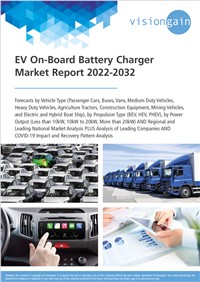The EV On-Board Battery Charger Market Report 2022-2032: This report will prove invaluable to leading firms striving for new revenue pockets if they wish to better understand the industry and its underlying dynamics. It will be useful for companies that would like to expand into different industries or to expand their existing operations in a new region.
Factors Such As The tremendous growth in the sales of electric vehicles, The growing demand for fast chargers, and The high cost of charging an electric vehicle at public charging stations Are Driving The Market Growth
Some of the major forces propelling the global EV On-Board Battery Charger market include the tremendous growth in the sales of electric vehicles, the growing demand for fast chargers, and the high cost of charging an electric vehicle at public charging stations. Furthermore, rapid growth in the number of smart cities across the globe is expected to create an opportunity for the EV onboard battery charger manufacturers. Government initiatives are the need of the hour to grow the electric vehicle (EV) on-board battery charger market. As a part of government initiatives in this domain, they are investing in the development of electric vehicles (EV). This will lead to more investment and research to develop electric vehicles (EV) and onboard battery charger propulsion type.
On the other hand, growing adoption of fast DC chargers coupled with lack of standardization of onboard battery chargers is restraining the market growth of electric vehicles globally. Despite the increase in demand, there is a problem that is plaguing the electric vehicle industry. Many developing Asian and African countries have poor infrastructure when it comes to electric vehicle charging stations, which is hampering their growth.
Lack of Infrastructure Challenges
A lack of infrastructure networks in most developing countries is putting a brake on the market for Electric Vehicle onboard battery chargers. In some regions, for example, it takes more than an hour to fully charge an Electric Vehicle, which is a deterrent for most people. Charging station networks are essential if Electric Vehicle markets are to grow in these regions. Governments need to plan a strategy of subsidies and incentives to encourage the growth of Electric Vehicle charging infrastructure. In countries such as India, Brazil, South Africa and Argentina, critical urban infrastructure such as public charging stations are limited. This is expected to create a challenge for the EV onboard battery charger manufacturers.
What Are These Questions You Should Ask Before Buying A Market Research Report?
- How is the EV On-Board Battery Charger market evolving?
- What is driving and restraining the EV On-Board Battery Charger market?
- How will each EV On-Board Battery Charger submarket segment grow over the forecast period and how much revenue will these submarkets account for in 2032?
- How will the market shares for each EV On-Board Battery Charger submarket develop from 2022 to 2032?
- What will be the main driver for the overall market from 2022 to 2032?
- Will leading EV On-Board Battery Charger markets broadly follow the macroeconomic dynamics, or will individual national markets outperform others?
- How will the market shares of the national markets change by 2032 and which geographical region will lead the market in 2032?
- Who are the leading players and what are their prospects over the forecast period?
- What are the EV On-Board Battery Charger projects for these leading companies?
- How will the industry evolve during the period between 2022 and 2032? What are the implication of EV On-Board Battery Charger projects taking place now and over the next 10 years?
- Is there a greater need for product commercialisation to further scale the EV On-Board Battery Charger market?
- Where is the EV On-Board Battery Charger market heading? And how can you ensure you are at the forefront of the market?
- What can be the best investment options for new product and service lines?
- What are the key prospects for moving companies into a new growth path? C-suite?
You need to discover how this will impact the EV On-Board Battery Charger market today, and over the next 10 years:
- Our 337-page report provides 123 tables and 233 charts/graphs exclusively to you.
- The report highlights key lucrative areas in the industry so you can target them – NOW.
- Contains in-depth analyse of global, regional and national sales and growth
- Highlights for you the key successful trends, changes and revenue projections made by your competitors
This report tells you TODAY how the EV On-Board Battery Charger market will develop in the next 10 years, and in-line with the variations in COVID-19 economic recession and bounce. This market is more critical now than at any point over the last 10 years.
Delivers exclusive COVID-19 variations economic data specific to your market.
Forecasts to 2032 and other analyses reveal the commercial prospects
- In addition to revenue forecasting to 2032, our new study provides you with recent results, growth rates, and market shares.
- You find original analyses, with business outlooks and developments.
- Discover qualitative analyses (including market dynamics, drivers, opportunities, restraints and challenges), cost structure, impact of rising EV On-Board Battery Charger prices and recent developments.
This report includes data analysis and invaluable insight into how COVID-19 will affect the industry and your company. Four COVID-19 recovery patterns and their impact, namely, V, L, W and U are discussed in this report.
Segments Covered in the Report
Vehicle Type
- Passenger Cars
- Buses, Vans
- Medium Duty Vehicles
- Heavy Duty Vehicles
- Agriculture Tractors
- Construction Equipment
- Mining Vehicles
- Electric and Hybrid Boat ship
Propulsion Type
- BEV
- HEV
- PHEV
Power Output
- Less than 10kW
- 10kW to 20kW
- More than 20kW



